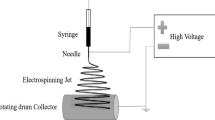Abstract
In this work, PAN fibers web was fabricated by Electrospinning, and then was pre-oxidated. Effect of the temperature on the structure and property of pre-oxidation web was discussed. The results showed that better level of pre-oxidation nanofibers web can be obtained when the pre-oxidation temperature is 250 °C. At this temperature, Infrared Spectroscopy showed that cyclization and dehydrogenation reaction have occurred and DSC curves showed that cyclization was basically complete, as well as moisture content can be appropriately controlled. Moreover, the preoxidated web with better breaking strength, elongation at break, and the initial modulus could be obtained.










Similar content being viewed by others
References
Reyes-de Vaaben S, Aguilar A, Avalos F, Ramos-de Valle LF. Carbon nanoparticles as effective nuclecting agents for polypropylene. J Therm Anal Calorim. 2008;93:947–52.
Szeluga U, Kurzeja L, Galina H. Dynamic mechanical properties of epoxy/novolac system modified with reactive liquid rubber and carbon filler. J Therm Anal Calorim. 2008;92:813–20.
Yang MW, Wang CG, Wang X. The pre-oxidation process of PAN precursor. Synth fiber ind. 2005;28:5–8.
Liu HZ, Wang CG. PAN fiber pre-oxidation process to its structure and properties. Appl High-Tech Fiber. 2006;2:31–5.
Worasuwannarak N, Nakagawa H, Miura K. Effect of pre-oxidation at low temperature on the carbonization behavior of coal. Fuel. 2002;81:1477–84.
Tsai JS. Comparison of batch and continuous oxidation processes for producing carbon fiber based on PAN fiber. J Mater Sci. 1997;16:361–2.
Lu CL, Wang M. Effect of pre-oxidation on the development of porosity in activated carbons from petroleum coke. Carbon. 2007;45(1):206–9.
Wang PH, Liu J, Li RY. Physical modification of polyacrylonitrile precursor fiber: its effect on mechanical properties. J Appl Polym Sci. 1994;52:1667–74.
Zhao LR, Jang BZ. The oxidation behavior of low-temperature heat-treated carbon fibres. J Mater Sci. 1997;32:2811–9.
Mukesh KJ, Balasubrmanian M, Desai P. Conversion of acrylonitrile-based precursors to carbon fibers, Part 2 Precursor morphology and thermooxidative stabilization. J Mater Sci. 1987;22:301–12.
Acknowledgements
The work is supported by Grant 10602014 from National Natural Science Foundation of China and Foundation for the Author of National Excellent Doctoral Dissertation of PR China.
Author information
Authors and Affiliations
Corresponding author
Rights and permissions
About this article
Cite this article
Qin, XH. Structure and property of electrospinning PAN nanofibers by different preoxidation temperature. J Therm Anal Calorim 99, 571–575 (2010). https://doi.org/10.1007/s10973-009-0126-0
Received:
Accepted:
Published:
Issue Date:
DOI: https://doi.org/10.1007/s10973-009-0126-0




